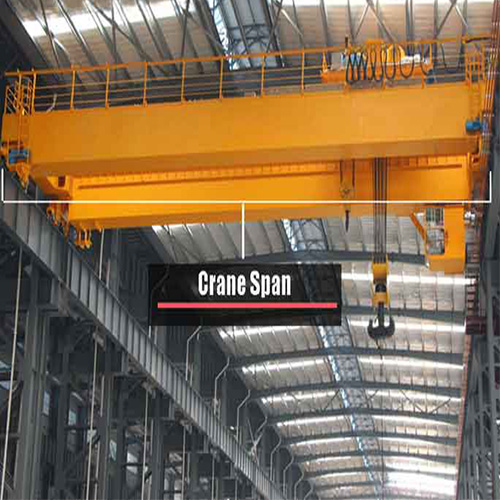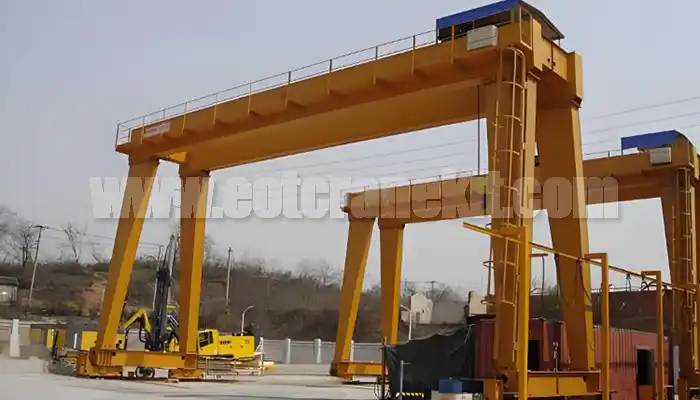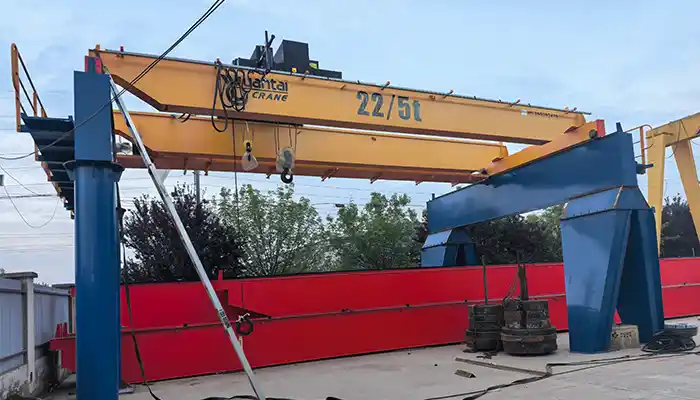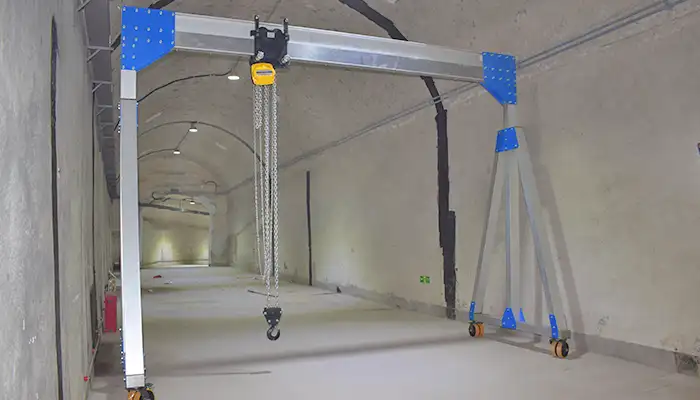Overhead Crane Span & Factory Workshop Span, How Much Do You Know
Overhead crane basics on crane span. A practical guide to standard overhead crane spans, workshop span and factory span to optimize material handling.
Category: Crane Basics
Your Trusted Overhead Travelling Crane Manufacturer & Supplier
Overhead Crane Span & Factory Workshop Span, How Much Do You Know
Overhead crane basics on crane span. A practical guide to standard overhead crane spans, workshop span and factory span to optimize material handling.
Optimizing Material Handling: A Practical Guide to Standard Overhead Crane Spans
Efficient material handling is the backbone of any successful workshop or manufacturing facility. From moving raw materials to handling finished products, the smooth flow of materials is essential for maintaining productivity and meeting customer demands. At the heart of this process are overhead cranes, which play a crucial role in optimizing material handling operations.
Importance of Efficient Material Handling in Workshops:
In workshops, efficient material handling is paramount for several reasons. Firstly, it directly impacts productivity and workflow efficiency. By streamlining the movement of materials, workshops can minimize downtime and maximize output. Secondly, efficient material handling contributes to workplace safety. Properly organized and controlled material flows reduce the risk of accidents and injuries, creating a safer working environment for employees. Lastly, efficient material handling also has a significant impact on cost-effectiveness. By reducing waste, minimizing damage to materials, and optimizing resource utilization, workshops can achieve cost savings and improve their bottom line.
Overhead cranes are indispensable tools in the quest for efficient material handling. These versatile machines provide a reliable means of lifting, moving, and positioning heavy loads within the workshop environment. By utilizing overhead cranes, workshops can overcome the limitations of manual handling methods and achieve higher levels of productivity and precision. From loading and unloading materials to transporting them between workstations, overhead cranes play a vital role in every stage of the material handling process.
The purpose of this guide is to provide workshop owners, managers, and operators with a comprehensive resource for understanding and selecting the right overhead crane span for their specific needs. We'll cover everything from the basics of workshop spans and crane spans to practical guidelines for selecting the optimal crane span length. Whether you're setting up a new workshop or looking to upgrade your existing material handling equipment, this guide will equip you with the knowledge and tools you need to make informed decisions and optimize your material handling operations.
Overview of Workshop and Factory Spans
When we talk about workshop and factory spans, we're referring to the width or span of the building or workspace where manufacturing activities take place. This span plays a crucial role in determining the layout, organization, and efficiency of material handling within the facility.
In simpler terms, the workshop or factory span is the distance across the building from one side to the other. It's essential to understand this measurement accurately to ensure that the crane span, which we'll discuss later, aligns correctly with the workshop or factory layout.
Factors Influencing Workshop Span Requirements:
Industry Sector (e.g., Heavy Manufacturing, Light Manufacturing):
Different industry sectors have varying requirements when it comes to workshop spans. Heavy manufacturing industries, such as automotive or steel fabrication, may require larger spans to accommodate heavy machinery and equipment. On the other hand, light manufacturing industries, like electronics assembly, may require smaller spans due to handling smaller components. Different industry sectors have varying requirements when it comes to workshop spans due to the nature of their operations and the size and type of equipment they use.
Heavy Manufacturing: Examples: Automotive, steel fabrication, shipbuilding, aerospace.
- Span Requirements: Large spans are necessary to accommodate heavy and large machinery, assembly lines, and to facilitate the movement of oversized materials.
- Considerations: These industries often require wide and high bays to allow for the installation and operation of cranes and other heavy lifting equipment. The layout must support extensive and uninterrupted floor space to handle large-scale assembly and fabrication processes.
Light Manufacturing: Examples: Electronics assembly, textile manufacturing, food processing.
- Span Requirements: Smaller spans are typically sufficient since the machinery and components are smaller and lighter.
- Considerations: The focus is often on creating efficient production lines with tightly packed machinery and workstations. Cleanroom environments and precision manufacturing might necessitate specific environmental controls, impacting the span and layout.
Operational Needs and Processes:
The specific operational needs and processes within a workshop influence span requirements. Factors such as the size and weight of materials being handled, the layout of production lines, and the frequency of material movement all play a role in determining the ideal workshop span.
The specific operational needs and processes within a workshop significantly influence span requirements.
Size and Weight of Materials:
- Heavy materials and large components necessitate larger spans to facilitate safe and efficient handling and movement.
- Light materials allow for closer spacing of machinery and workstations, reducing the need for extensive spans.
Layout of Production Lines:
- Linear, continuous production lines in heavy manufacturing may require large, open spaces without interruptions.
- Modular or cellular layouts in light manufacturing might fit into smaller spans and more confined spaces.
Frequency of Material Movement:
- High-frequency movement of large items in heavy manufacturing demands wide, unobstructed spans to accommodate transport systems like conveyors and cranes.
- In light manufacturing, material movement might be handled by smaller automated systems or manual processes, requiring less span width.
Building Layout and Dimensions:
The layout and dimensions of the workshop itself impact span requirements. Factors such as the height of the building, the presence of columns or obstructions, and the overall layout of the workspace need to be taken into account when determining the appropriate span.
The overall layout and dimensions of the workshop impact span requirements significantly.
Building Height:
- Taller buildings can accommodate overhead cranes and large machinery, necessitating larger spans.
- Shorter buildings may be sufficient for light manufacturing processes that don't require extensive vertical space.
Presence of Columns or Obstructions:
- Columns can limit the effective span and require careful planning to avoid disrupting production lines in heavy manufacturing.
- Light manufacturing might be more adaptable to spaces with columns, as the equipment and workstations are smaller and more flexible in layout.
Workspace Layout:
- Open floor plans are ideal for heavy manufacturing to allow free movement of large machinery and materials.
- More compartmentalized layouts may work well in light manufacturing where different processes can be isolated for efficiency or cleanliness.
Safety Considerations and Regulations:
Safety considerations and regulatory requirements also influence span requirements. Building codes, safety standards, and regulations may dictate minimum clearance distances, load capacities, and other factors that impact span selection to ensure the safety of workers and equipment. Meeting these regulations is essential to maintain a safe working environment and ensure compliance with legal requirements.
Safety and regulatory requirements are crucial factors in determining span requirements.
- Building Codes: Local building codes dictate minimum structural standards, including load capacities and safety clearances, which directly impact the design of spans.
- Safety Standards: Occupational safety standards may require specific clearance distances around machinery, which influence span decisions to ensure safe operation.
- Regulations: Compliance with regulations for specific industries, such as fire safety codes, environmental regulations, and ergonomic standards, will affect the layout and span design.
- Ensuring proper ventilation, emergency exits, and safe walkways are all regulatory considerations that impact span requirements.
Determining the appropriate workshop span involves a multifaceted approach that considers the specific demands of the industry sector, operational needs and processes, building layout and dimensions, and adherence to safety considerations and regulations. Each of these factors plays a critical role in creating an efficient, safe, and compliant workshop environment.
Basics of Crane Span Calculation
The crane span, also known as the bridge span or runway span, refers to the distance between the rails on which the overhead crane travels. It's a critical dimension that determines the coverage area of the crane within a workshop or factory. A properly sized crane span ensures that the crane can effectively traverse the width of the workspace and handle materials with precision and efficiency.
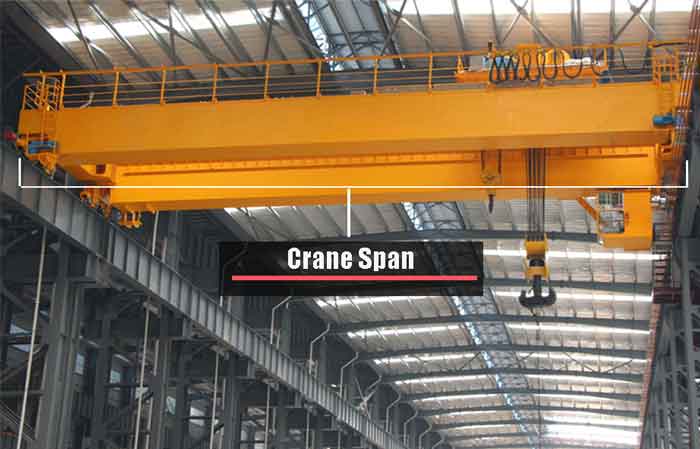
Crane span of overhead crane
Relationship between Workshop Span and Crane Span:
The crane span is directly related to the workshop span, which is the width of the workshop or factory where the crane will be operating. The crane span should be equal to or slightly greater than the workshop span to ensure that the crane can cover the entire width of the workspace without limitations. Matching the crane span to the workshop span is essential for optimizing material handling operations and maximizing the use of available space. The crane span and workshop span are closely linked, and their relationship is vital for the efficient and effective operation of the crane within the workspace.
- Workshop Span: The total width of the workshop or factory, often measured from wall to wall.
- Crane Span: The distance between the two rails on which the crane travels, which should match the workshop span to ensure optimal coverage.
- Optimizing Material Handling: - Ensuring the crane span matches the workshop span allows the crane to cover the entire width of the workspace, enabling it to reach all areas without any limitations. - This alignment maximizes the use of available space, allowing for efficient movement and handling of materials across the entire workshop.
- Operational Efficiency: - A crane span equal to or slightly greater than the workshop span ensures that the crane can operate without restrictions, facilitating seamless workflow and reducing the need for manual handling. - This setup supports the handling of large and heavy items by providing consistent access across the entire width of the workshop.
- Design and Installation: - During the design phase, it is crucial to measure the workshop span accurately and ensure that the crane span is configured accordingly. - Proper installation and alignment of the crane rails are essential to prevent operational issues and ensure smooth movement of the crane.
Considerations for Buffer and Clearance Distances:
When calculating the crane span, it's essential to consider buffer and clearance distances to ensure safe and efficient crane operation. Buffer distances account for factors such as crane movement, load swing, and safety margins, while clearance distances ensure adequate space for the crane to operate without interference from obstacles such as walls, columns, or equipment.
When determining the appropriate crane span, it is crucial to consider buffer and clearance distances to ensure safe and efficient operation.
- Buffer Distances: Crane Movement: Allow additional space for the crane to move smoothly along its rails without hitting end stops abruptly.
- Load Swing: Account for the potential swing of the load during lifting and transporting to prevent collisions with other equipment or structural elements.
- Safety Margins: Include safety buffers to accommodate any unexpected movements or operational anomalies, enhancing overall safety.
Clearance Distances:
Walls and Columns: Ensure there is sufficient clearance between the crane and any walls, columns, or structural obstructions. This prevents damage to both the crane and the building infrastructure.
- Equipment: Adequate clearance must be maintained around other equipment and machinery to avoid interference with crane operations. This includes ensuring pathways are clear for the crane to move freely.
- Height Clearances: Vertical clearance is also critical, especially for overhead cranes, to ensure there is enough space above the crane for safe operation and maintenance activities.
- Regulatory Compliance: Adhering to industry standards and safety regulations is necessary to ensure the crane system is safe for operators and other personnel.
- Regulations often dictate minimum clearance distances and safety buffer requirements to prevent accidents and ensure smooth operation.
- Operational Considerations: Plan for routine maintenance and inspection access. Ensure that buffer and clearance distances are sufficient to allow maintenance personnel to perform their tasks safely and efficiently.
- Consider the potential for future changes or expansions in the workshop layout that might affect crane operation, and design buffer and clearance distances to accommodate such changes.
The relationship between workshop span and crane span is critical for optimizing material handling operations. Ensuring that the crane span matches the workshop span enables full coverage of the workspace and maximizes efficiency. Additionally, incorporating buffer and clearance distances is essential for safe and efficient crane operation, preventing collisions and ensuring compliance with safety regulations. These considerations help create a well-designed and functional workshop environment that supports smooth and safe crane operations.
Calculation Methods for Determining Crane Span:
- Simple Formulae Based on Workshop Width: One straightforward method for determining crane span is to use a simple formula based on the width of the workshop. By adding a buffer or clearance distance to the workshop width, you can calculate the crane span needed to cover the entire workspace effectively.
- Advanced Calculations for Specific Requirements: In some cases, more advanced calculations may be necessary to determine the crane span accurately. Factors such as load capacity, crane type, and specific operational requirements may require more detailed analysis to ensure optimal crane performance and safety.
Consulting with crane manufacturers or engineering professionals can provide valuable insights and assistance in performing advanced calculations and selecting the right crane span for your specific requirements.
By understanding the basics of crane span calculation and considering factors such as buffer and clearance distances, workshop owners can ensure that their crane systems are optimized for efficient and safe material handling operations. Whether using simple formulae or advanced calculations, selecting the right crane span is essential for maximizing productivity and minimizing downtime in the workshop or factory.
In some cases, more advanced calculations may be necessary to determine the crane span accurately. Factors such as load capacity, crane type, and specific operational requirements may require more detailed analysis to ensure optimal crane performance and safety. Consulting with crane manufacturers or engineering professionals can provide valuable insights and assistance in performing advanced calculations and selecting the right crane span for specific requirements.
Selection Criteria Based on Workshop or Factory Needs:
When choosing an overhead crane type for a workshop or factory, it is important to evaluate several critical factors to ensure the selected crane meets specific operational requirements and constraints. Here are the key criteria to consider:
Required Lifting Capacity
Determine Load Requirements:
Assess the maximum weight of the materials or equipment that the crane will need to lift and transport.
Consider the heaviest load the crane will handle regularly and any potential future increases in load requirements.
Crane Types:
Single Girder Cranes: Suitable for light to moderate lifting needs (typically up to 20 tons).
Double Girder Cranes: Better for heavier loads and higher capacities (above 20 tons).
Available Space and Clearance Heights
Workshop Dimensions:
Measure the available floor space and vertical clearance in the workshop or factory.
Consider the height of the ceiling, the presence of obstructions (such as lighting fixtures, HVAC systems, or structural beams), and the required clearance for safe crane operation.
Crane Types:
Low Headroom Cranes: Ideal for environments with limited vertical space.
Underhung Cranes: Mounted to the ceiling rather than floor-supported, useful for maximizing floor space.
Top Running Cranes: Suitable for workshops with ample headroom.
Operational Requirements and Processes
Workflow and Usage:
Evaluate the specific operational processes and workflow within the workshop.
Determine how frequently the crane will be used, the types of movements required (e.g., lifting, lowering, horizontal travel), and any special operational requirements (e.g., high precision, speed).
Crane Features:
Manual vs. Electric: Choose between manual cranes for infrequent or lighter use and electric cranes for more intensive operations.
Control Systems: Options include pendant controls, wireless remote controls, and automated systems for various levels of precision and convenience.
Budget Constraints
Cost Considerations:
Establish a budget for the crane system, including installation, maintenance, and potential upgrades.
Balance initial investment costs with long-term operational efficiency and maintenance expenses.
Cost-Effective Solutions:
Single Girder Cranes: Generally less expensive and suitable for lower budgets.
Pre-owned or Refurbished Cranes: Can provide significant cost savings while meeting operational needs.
Environmental Factors
Indoor vs. Outdoor Operation:
Determine whether the crane will be used indoors, outdoors, or in a combination of both environments.
Assess environmental conditions such as temperature, humidity, exposure to elements, and potential corrosive environments.
Crane Types and Features:
Weatherproof Cranes: For outdoor use, select cranes with weatherproofing features and corrosion-resistant materials.
Temperature and Humidity Control: Ensure the crane can operate reliably under specific environmental conditions present in the workshop or factory.
Pros and Cons of Crane Types:
- Single Girder Overhead Cranes: Pros: Cost-effective, lighter structure, easier installation and maintenance. Cons: Lower load capacity, limited to lighter applications.
- Double Girder Overhead Cranes: Pros: Higher load capacity, greater stability, suitable for heavy-duty applications. Cons: Higher cost, more complex installation and maintenance.
- Underhung (Suspension) Cranes: Pros: Saves floor space, suitable for limited headroom. Cons: Limited load capacity, requires robust ceiling support.
- Top Running Overhead Cranes: Pros: Suitable for heavy loads, maximizes vertical clearance. Cons: Requires strong structural support, higher installation cost.
Selecting the appropriate overhead crane for a workshop or factory involves a careful evaluation of factors such as required lifting capacity, available space and clearance heights, operational requirements, budget constraints, and environmental conditions. By considering these criteria and understanding the advantages and disadvantages of different crane types, workshop and factory owners can choose a crane system that best meets their specific needs and ensures efficient and safe operations.
Standard Overhead Crane Span Lengths
Standard crane span lengths are predetermined measurements that are commonly used in workshop and manufacturing environments. These standard lengths are based on industry standards, safety regulations, and practical considerations for efficient material handling operations.
The standard factory or workshop span can vary widely depending on factors such as local building codes, industrial standards, and the specific needs of the businesses operating in those countries. However, I can provide some general ranges based on common practices in different regions:
- United States: Factory or workshop spans in the US can range from around 30 feet (9 meters) to over 100 feet (30 meters) or more, depending on factors such as the type of industry, building codes, and available space.
- China: In China, factory spans can range from about 15 meters to 30 meters or more. This is influenced by factors such as the size of manufacturing operations, land availability, and local building regulations.
- European Union: Factory spans in European countries can vary, but they often fall within a similar range as those in the US, typically between 9 meters and 30 meters or more, depending on factors such as local regulations and industrial standards.
- Japan: Factory spans in Japan can be similar to those in other developed countries, ranging from around 9 meters to 30 meters or more, depending on factors such as land availability and industrial requirements.
Sure, here's a tabular representation of the general standard factory or workshop spans in different countries:
Country | Factory/Workshop Span Range |
United States | 30 feet (9 meters) to over 100 feet (30 meters) or more |
China | About 15 meters to 30 meters or more |
European Union | 9 meters to 30 meters or more |
Japan | Around 9 meters to 30 meters or more |
Typical Crane Span Lengths for Different Workshop Sizes:
Standard overhead crane span | 9 | 12 | 15 | 18 | 21 | 24 | 27 | 30 |
Stanard crane span length of 3-50ton overhead cranes | 7.5 | 10.5 | 15 | 16.5 | 19.5 | 22.5 | 25.5 | 28.5 |
Stanard crane span length of 80-250ton overhead cranes | 7 | 10 | 13 | 16 | 19 | 22 | 25 | 25 |
- Small Workshops: In small workshops, crane span lengths typically range from 7 meters to 15 meters. These workshops often handle lighter loads and have limited space for material handling equipment.
- Medium-Sized Workshops: Medium-sized workshops may require crane span lengths ranging from 15 meters to 30 meters. These workshops accommodate moderate loads and have a moderate amount of space for material handling operations.
- Large Workshops: Large workshops may require crane span lengths exceeding 30 meters. These workshops handle heavy loads and have ample space for material handling equipment and operations.
Crane Span Lengths for Different Industrial Sectors:
When considering workshop spans in different industry sectors, the specific requirements can vary significantly based on the nature of the operations, the size of the equipment, and the type of products being manufactured. Here's a more detailed look at how different sectors might approach workshop spans:
Heavy Manufacturing
- Automotive Industry:
Span Requirements: Larger spans are essential to accommodate the assembly lines, large machinery, and robotic systems.
Considerations: Wide bays are needed for vehicle assembly, testing, and painting areas. Overhead cranes and heavy-duty material handling systems are also commonly used, necessitating robust structural support. - Steel Fabrication:
Span Requirements: Very large spans to handle oversized steel components, heavy machinery, and welding equipment.
Considerations: The space must support the movement of large, heavy materials and provide room for heavy-duty cranes that can transport large steel beams and plates. - Shipbuilding:
Span Requirements: Extremely large spans to build and assemble large sections of ships.
Considerations: Requires significant overhead clearance and heavy lifting capacity to maneuver large ship sections and heavy machinery.
Light Manufacturing
- Electronics Assembly:
Span Requirements: Smaller spans are typically sufficient due to the handling of smaller, more delicate components.
Considerations: Cleanroom environments and precision assembly areas may need specific design features like controlled environments and anti-static flooring. - Textile Manufacturing:
Span Requirements: Moderate spans to accommodate looms and sewing machines.
Considerations: The layout often requires long, narrow spaces for rows of machinery, with good lighting and ventilation to maintain a comfortable working environment. - Food Processing:
Span Requirements: Moderate spans to accommodate processing lines and packaging machinery.
Considerations: Hygiene and safety regulations influence the design, with requirements for easy-to-clean surfaces, proper drainage, and controlled environments for different stages of processing.
Specific Considerations
Machinery Size and Movement:
Heavy manufacturing often involves large, immobile machinery that requires substantial space to operate safely and efficiently.
Light manufacturing typically involves smaller, more mobile equipment, allowing for denser packing of machinery and workstations.
Material Handling:
In heavy manufacturing, the need for large cranes and forklifts to move heavy materials influences the span and structure of the workshop.
Light manufacturing might utilize conveyor belts, small carts, and manual handling, which do not require as much overhead space or structural support.
Production Processes:
Heavy industries often have processes that require large, open spaces to assemble large products or move heavy parts.
Light industries may focus on high-volume production of small items, requiring less space per unit and more focus on efficiency and workflow within smaller spans.
Safety and Accessibility:
Larger spans in heavy manufacturing also ensure that there is adequate space for safe operation and maintenance of equipment, as well as emergency access.
In light manufacturing, the focus is on creating efficient workspaces where operators can easily access and work on smaller components.
In summary, the requirements for workshop spans vary greatly between heavy and light manufacturing sectors due to the different scales of operations, types of machinery, and production processes involved. Heavy manufacturing demands larger spans for accommodating bulky equipment and heavy materials, while light manufacturing can operate within smaller spans, focusing on efficiency and precision for handling smaller components.
Practical Guidelines for Crane Buyers
Step-by-Step Process for Selecting Crane Spans:
- Assess Workshop or Factory Span: Measure the width of the workspace where the crane will operate.
- Consider Buffer and Clearance Distances: Account for factors such as crane movement, load swing, and safety margins.
- Calculate Crane Span: Determine the crane span needed to cover the entire width of the workspace effectively.
- Evaluate Crane Types: Consider single-girder, double-girder, box girder, or gantry cranes based on lifting capacity and operational requirements.
- Consult with Crane Manufacturers: Discuss specific needs and requirements with crane manufacturers to select the most suitable crane system.
Evaluation of Workshop Layout and Operations
Evaluating the layout of the workshop or factory is crucial to ensure that the crane system can navigate the space effectively and support the operational processes with precision and efficiency.
- Analyze Material Flow:
Map out the entire workflow from the arrival of raw materials to the dispatch of finished products.
Identify critical areas where materials need to be lifted, moved, or stored. - Identify Operational Processes:
Understand the specific operational processes that will require crane usage. This includes assembly lines, processing stations, and storage areas.
Determine the frequency and type of movements (e.g., vertical lifts, horizontal transfers) required. - Consider Potential Obstacles:
Evaluate the workspace for potential obstructions such as columns, beams, machinery, and other equipment.
Ensure that the crane can move materials around these obstacles without disrupting the production flow. - Optimize Crane Placement:
Determine the optimal locations for crane rails or tracks to maximize coverage and efficiency.
Consider the need for multiple cranes or auxiliary lifting equipment in large or complex layouts.
Determining Load Capacity Requirements
Determining the maximum load capacity requirements is essential to select a crane system that can handle the materials safely and efficiently.
- Calculate Maximum Load:
Assess the heaviest single item or load that the crane will need to lift and move.
Include any attachments or fixtures that may add to the total weight. - Evaluate Load Size and Distribution:
Consider the dimensions and shape of typical loads to ensure they can be lifted without imbalance or instability.
Ensure the crane's lifting mechanism can accommodate varied load shapes and sizes. - Assess Frequency of Lifts:
Determine how often the crane will be used for lifting operations. High-frequency operations may require more durable and higher capacity cranes.
Consider the duty cycle of the crane to match the operational demands and prevent overuse.
Assessing Environmental Factors and Safety Regulations
Understanding environmental conditions and adhering to safety regulations are critical for selecting a crane system that operates reliably and safely.
- Evaluate Environmental Conditions:
Temperature: Ensure the crane can operate within the temperature range of the workshop. Extreme temperatures may require special components or insulation.
Humidity and Corrosive Conditions: If the workshop is in a humid or corrosive environment, choose cranes with appropriate protective coatings and materials to prevent corrosion and wear. - Ensure Regulatory Compliance:
Adhere to local building codes and industry-specific regulations that dictate safety standards for crane operation.
Consider load capacities, clearances, safety barriers, and emergency stop mechanisms as mandated by regulations. - Safety Standards:
Implement safety features such as overload protection, limit switches, and emergency stop controls.
Regularly inspect and maintain the crane to ensure it meets ongoing safety standards.
Consulting with Crane Manufacturers and Suppliers
Consulting with experienced crane manufacturers and suppliers can provide valuable insights and help in selecting the most suitable crane system for your needs.
- Discuss Requirements:
Clearly communicate your operational requirements, including load capacities, workspace layout, environmental conditions, and budget constraints.
Provide detailed information about the types of materials, lifting processes, and operational challenges you face. - Seek Professional Guidance:
Request recommendations for crane systems that match your specific needs.
Discuss the pros and cons of different crane types and configurations. - Budget Considerations:
Work with suppliers to find cost-effective solutions that meet your requirements without compromising on quality and safety.
Consider long-term costs, including maintenance, energy consumption, and potential future upgrades. - Installation and Support:
Ensure that the supplier provides comprehensive installation services and support.
Look for suppliers that offer training for operators, ongoing maintenance services, and quick response times for repairs and parts replacement.
Selecting the right overhead crane system for a workshop or factory involves a thorough evaluation of the layout and operations, determining load capacity requirements, assessing environmental factors and safety regulations, and consulting with crane manufacturers and suppliers. By carefully considering these criteria, workshop and factory owners can ensure they choose a crane system that meets their specific needs, enhances operational efficiency, and maintains a safe working environment.
Budget Considerations and Long-Term Maintenance Plans
When selecting a crane system, it is essential to consider not only the initial investment but also the long-term costs associated with owning and maintaining the equipment. Here's a detailed approach to managing budget constraints and developing a comprehensive maintenance plan:
Budget Considerations
Initial Purchase Price:
Assess the upfront cost of the crane system, including any customization required to meet specific operational needs.
Compare different models and brands to find a balance between cost and quality.
Installation Costs:
Include costs for installing the crane, which may involve structural modifications to the workshop, rail installation, and electrical work.
Ensure that installation is performed by qualified professionals to avoid issues and additional costs later on.
Total Cost of Ownership (TCO):
Evaluate the TCO, which encompasses all costs associated with the crane over its entire lifespan.
Components of TCO:
Initial Cost: Purchase and installation.
Operational Costs: Energy consumption, operator training, and any required certifications.
Maintenance Costs: Regular maintenance, inspections, parts replacement, and unexpected repairs.
Depreciation: The loss of value over time and the potential resale value of the crane.
Budget Planning:
Set a realistic budget that includes a buffer for unexpected expenses.
Prioritize essential features and capabilities that align with your operational needs to avoid overspending on unnecessary options.
Long-Term Maintenance Plans
- Developing a Maintenance Plan:
Create a detailed maintenance schedule that includes regular inspections, routine servicing, and preventive maintenance tasks.
Ensure the plan covers all components of the crane system, including mechanical, electrical, and structural elements. - Routine Inspections:
Conduct regular inspections to identify wear and tear, potential safety hazards, and performance issues.
Use a checklist to ensure all critical components are examined, including the hoist, trolley, rails, and control systems. - Preventive Maintenance:
Implement preventive maintenance practices to address issues before they lead to breakdowns or costly repairs.
This can include lubrication of moving parts, tightening of bolts and connections, and calibration of control systems. - Scheduled Servicing:
Follow the manufacturer's recommended service intervals for more thorough maintenance tasks.
Engage qualified technicians for tasks that require specialized knowledge or equipment. - Repair and Parts Replacement:
Keep an inventory of essential spare parts to minimize downtime in case of a breakdown.
Establish a relationship with reliable suppliers to ensure quick access to replacement parts. - Training and Documentation:
Train crane operators and maintenance personnel on proper use and maintenance procedures.
Maintain detailed records of all maintenance activities, including dates, tasks performed, and parts replaced, to track the crane's condition over time. - Safety Compliance:
Ensure that the maintenance plan includes regular checks to comply with safety regulations and standards.
Periodic safety audits can help identify and rectify potential safety issues.
Considering budget constraints and developing a long-term maintenance plan are critical steps in selecting and managing an overhead crane system. Evaluating the total cost of ownership, including initial costs, installation, and ongoing maintenance, helps in making an informed decision that balances cost and functionality. A comprehensive maintenance plan ensures the crane system remains reliable, safe, and efficient throughout its lifespan, ultimately protecting the investment and enhancing operational productivity.
Conclusion
Recap of Key Points and Takeaways:
- Workshop efficiency relies heavily on the proper selection of overhead crane spans.
- Understanding the relationship between workshop spans and crane spans is essential for optimizing material handling operations.
- Factors such as workshop layout, load capacity requirements, environmental considerations, and safety regulations must be carefully evaluated when selecting crane spans.
- Consulting with crane manufacturers, suppliers, and industry experts can provide valuable guidance and assistance in the crane span selection process.
Importance of Proper Overhead Crane Span Selection for Workshop Efficiency:
- Proper overhead crane span selection is critical for maximizing workshop efficiency, productivity, and safety.
- Matching crane spans to workshop requirements ensures optimal material handling operations and minimizes downtime.
- Selecting the right crane spans helps to maximize workspace utilization, reduce material handling costs, and enhance overall operational efficiency in the workshop.
Resources for Further Information and Assistance:
- For further information and assistance on overhead crane span selection, workshop owners and operators can consult with crane manufacturers, suppliers, and industry associations.
- Online resources, industry publications, and educational materials provide additional insights and guidance on crane span selection criteria, best practices, and case studies.
- Take advantage of available resources to stay informed and make well-informed decisions when selecting overhead crane spans for your workshop or manufacturing facility.
In conclusion, proper overhead crane span selection is essential for optimizing workshop efficiency and ensuring safe and efficient material handling operations. By understanding key considerations, consulting with experts, and utilizing available resources, workshop owners and operators can select the right crane spans to meet their specific needs and achieve success in the workplace.
Appendices
Glossary of Terms:
- Workshop Span: The width or span of the workshop or manufacturing facility.
- Crane Span: The distance between the rails on which the overhead crane travels.
- Buffer Distance: Additional space added to the crane span to account for crane movement, load swing, and safety margins.
- Clearance Distance: Space required around the crane for safe operation without interference from obstacles.
- Load Capacity: The maximum weight that a crane is designed to lift and move.
- Material Handling: The movement, control, and storage of materials within a facility or workspace.
- Overhead Crane: A type of crane that operates on an elevated track or runway system.
Sample Calculation Worksheets:
- Sample calculation worksheets for determining crane span based on workshop width and buffer distances.
- These worksheets provide practical tools for workshop owners and operators to use during the crane span selection process.
- Utilize these worksheets to calculate crane spans accurately and ensure optimal material handling operations within the workshop or manufacturing facility.
This comprehensive guide will provide workshop owners and managers with the necessary knowledge and tools to select the right overhead crane span for their specific workshop requirements, ultimately optimizing material handling efficiency and improving overall workshop productivity.
Main Projects
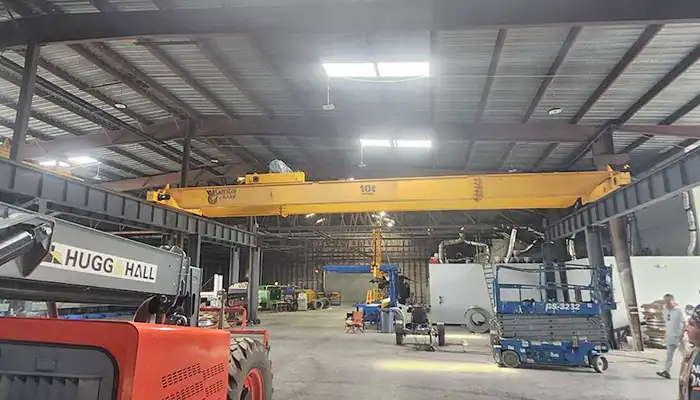
Affordable 10 ton double girder overhead crane with CD/MD hoist trolley, built for U.S. standards, ideal for construction and industrial lifting
Free consultation to Confirm Parameters & Specifications and Get
Latest Crane Price & Crane Rate.
- Types of overhead cranes : _______?
- Optional: Overhead travelling crane, goliath gantry crane,Slewing jib crane, Single girder or double girder crane,small portable crane or kbk crane, etc.
- Capacity of overhead crane: _______?
- Optional: 0.25ton, 0.5 ton, 1 ton, 2 ton, 3ton, 5 ton, 10 ton,15ton, 20ton, 25 ton, 30ton,35ton, up to 550ton, etc.
- Crane span & lifting height : _______?
- Crane travelling length : _____?
- Control of overhead crane:_______?
- Optional: pendant/ remote/cabin control
- Voltage supply of overhead crane:_____?
- Eg,: 380V50/60HZ,3Phase or others,etc.
- Application/usage of crane:_______?
- Eg,: Steel mill, ,injection mold, cement,stone, concrete,granite, general manufacturing, etc.
Just leave a message via the contact form and our hoist and crane engineer will contact you with in 24working hours.
Get In Touch
